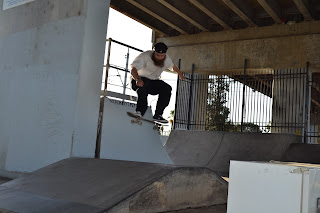Rabbi takes a leap of faith
Image and article by Shane Scanlan (Editor of Docklands News)
28 Feb 2012
He’s the skateboarding rabbi and he’s not afraid to take a leap of faith into the best street skating that Melbourne can offer.
Rabbi Dovid Tsap articulates what all Melbourne skateboarders know – that outside of the many skateboard parks, Docklands offers the best skating around.
He can be found skating Docklands until 3 am some mornings, taking care to avoid residential areas so as not to disturb sleeping residents.
Rabbi Tsap, 34, is a mystic who spends his intellectual energy exploring the “more conspicuously spiritual side of Judaism”.
He writes a blog (http://spiritualskating.blogspot.com.au/) and communicates his thinking with people from all over the world. And he has recently published a book exploring the depths of Kabbalah.
Being a skateboarder has dual benefits for Rabbi Tsap. Apart from the health and wellbeing benefits he derives from the demanding sport, he clearly opens a respectful channel of communication with young people.
“The kids have some degree of admiration for me and pay attention to what I say,” he said. “They think of me as a friend. There is affinity and rapport.”
And while he has been a Rabbi for many years, he has only been the “Skating Rabbi” in recent times. Rabbi Tsap explained that he skated as a kid but gave it up when he was 15 years old.
He was encouraged by his friend Raph Brous to get back into skateboarding less than two years ago.
Since then he has seen the barriers between himself and young people diminish drastically.
“It was almost like they had too much reverence for me then,” he said. “It was a barrier to effective communication.”
He said it was now very easy to speak with young people about life, drugs and God.
“At last now I am starting to feel like a real rabbi,” he said.
Rabbi Tsap said that he wouldn’t have any particular credibility with youths if he was merely just able to just ride a skateboard around.
“I’m actually quite good at it and can land a number of difficult tricks,” he said.
He said skateboarding was cathartic for him.
“It's an aggressive thing to do and you need a lot of guts to attempt lots of these tricks. When I land a trick it just feels so good. The accomplishment makes me feel so happy,” he said. “And so I can transfer these feelings into other aspects of my life.”
He said the camaraderie and affinity between skateboarders was a revelation. He said when he was at Melbourne’s skateboarding parks he had friends from all religious and ethnic backgrounds.
“Skaters have a strong capacity for brotherhood,” he said.






.JPG)


.JPG)








